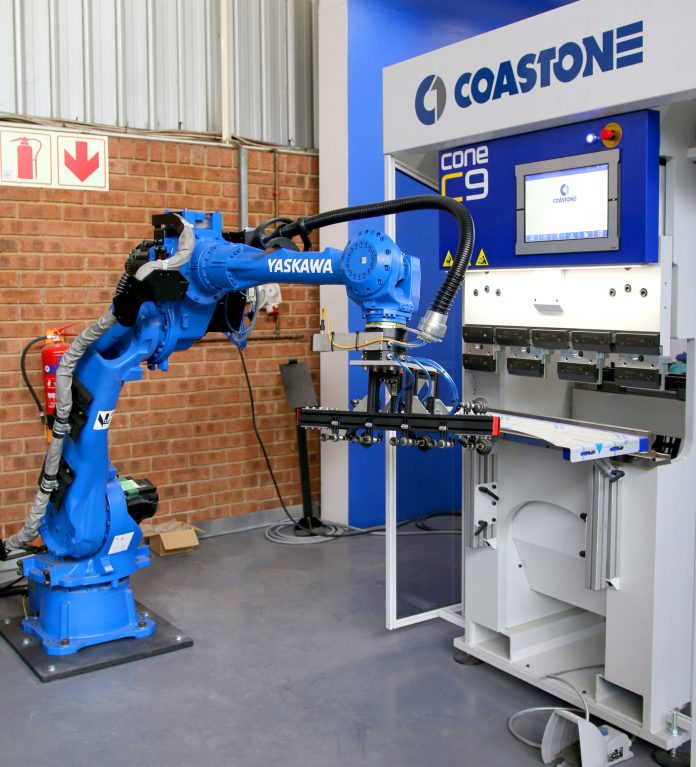When it comes to bending plate and sheet metals to precise angles and dimensions, there is no better suited machine than the press brake. As one of the many principle pieces of equipment in the metal industry, the press brake helps deliver custom parts to a range of industries including aviation, automotive, agricultural, energy, and transportation.
Conventionally, most press brakes are operated via programmable system inputs, but pieces of metal are still aligned and placed manually. A process which, thanks to a collaboration between the innovative minds at leading industrial robotics company Yaskawa Southern Africa and specialist machinery supplier Metal Chip Machinery, is about to change.
The robotics and press brake integration first established itself when Yaskawa Finland and European press brake manufacturer Coastone collaborated on a new solution five years ago, leading to a successful long standing relationship between the two companies and setting a precedent for a similar local partnership today.
“When we had an enquiry for a press brake robotic bending cell, it was a natural progression for us to talk to Metal Chip, who are the South African distributors of Coastone. The existing interface between the Coastone press brake and the Yaskawa robot makes high integration a lot easier,” says John Mostert, Sales Engineer at Yaskawa Southern Africa.
The opportunity to supply a customer in South Africa with a robotic press brake solution arose when an existing client requested a solution to speed up their manufacturing process. “The task was to create a solution for a company that uses sheet metal bending to manufacture electrical boxes, which are designed for domestic, factory and industrial use,” explains Malcom Moriarty, Owner of Metal Chip Machinery.
Mostert reveals the thought process behind the request. “The reason Yaskawa was approached, is that right now it is a very manual process. The customer’s press brake would require an operator that would have to be in front of the machine all the time but with a robot, we are able to automate the process therefore achieving higher volumes of production.”
Automation is synonymous with providing cost-effective solutions to customers and the press brake integrated with a Yaskawa robot aims to do just that. Mostert highlights the opportunity for local fabricators to rise above international competition. “The majority of electrical boxes that are sold in South Africa are very often produced in countries like China, so to remain price competitive, the cost per unit has to be reduced.”
With over a hundred years of industry experience, Yaskawa is no stranger when it comes to specific requests, as a regular part of its business involves creating tailor-made solutions for individual client needs. “Another task from the client was to produce a system that could also be used manually. For higher volume products, the robot is a necessity to reduce cost and increase production, but often, the customer would need smaller batches of specialised samples too.”
For all the benefits that robots and automation bring to the table, the most common follow up questions tend to be about maintenance. “When it comes to maintenance, very little is needed on the robot for at least the first seven to eight years, other than just the standard services,” says Mostert.
On the press brake side, Moriarty has experienced machines in perfect working order that have outlived his entire career so far and says that newer technologies are “essentially maintenance free as these are fully electric press brakes that use no hydraulic oils, eliminating the need for filter changes. They are operator friendly and easy to use.”
Press brakes are hardy machines that don’t wear easily, with many working perfectly even decades after purchase. “What does change over time is the software and controls that are simply modernised and updated”. Moriarty notes that the Yaskawa robot integrated press brake will be this client’s second press brake, building on their operational efficiency even further following their initial investment. “The first one already doubled their production in manual mode.”
On providing their client with an efficient solution, Mostert describes the functionality of Yaskawa’s integration. “The robot is fitted with a vacuum gripper device with suction cups that will pick up the various pieces of sheet metal and present them to the press brake for bending. The gripper is designed to easily handle the material despite its change in form after bending shape multiple times.” Before product delivery, Yaskawa provides all customers with training for the robot operators. This is followed by a collaborative process whereby both the press brake and robot are programmed and calibrated to spec.
With new opportunities to ramp up production and challenge international competition, the future of South African sheet metal fabrication is quickly bending back into shape. All Coastone press brakes are now available with the option of a Yaskawa robot interface already integrated, allowing for seamless plug and play connection.












